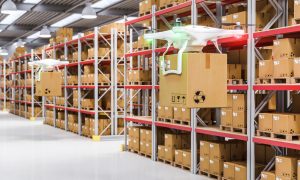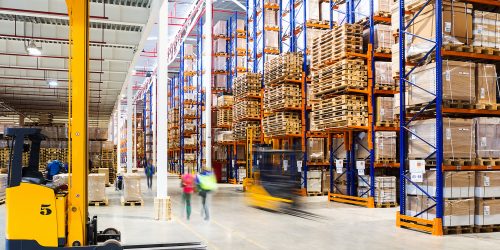What will the warehouse of the future look like?

We are hearing more and more about industry 4.0 and warehouse 4.0 in the world of logistics. This concept refers to the digital transformation of warehouses through the use of new technologies for various purposes. Find out how new technologies are transforming and will continue to transform the warehouses of the future to meet new consumer demands.
Industry 4.0 or the industry of new technologies
Considered the fourth industrial revolution, the concept of industry 4.0 is about harnessing the unique advantages that previous revolutions have created thus far: technology, automation (drones and robots), artificial intelligence, the Internet, and the ability to capture and process big data through data science.
It is important to recognise that industry 4.0 is not just about manufacturing and production operations. It applies equally to many other operational departments, such as warehousing operations. These constitute a closed physical space with a defined function and there are plenty of automation and technology options to choose from to build the right model(s) for your company.
The Internet of Things (IoT), big data and data science, augmented reality, computer vision, artificial intelligence (AI), low-cost sensors, cobots, and high-level computing can be combined to build a robust and automated warehouse system. As a result, warehouses and distribution centres are becoming “smart” and are an essential component of the supply chain.
Warehouse 4.0: a warehouse for the future
WMS (Warehouse Management System) tools are the core element of warehouse 4.0, but they are not a complete solution. The base instances of a WMS, depending on its implementation, provide data on what has been shipped, what has been received, and where it is stored. In other words, it is a classification and data processing system that can provide recommendations for action.
A smart warehouse goes far beyond a simple WMS. By following the route laid out in your company’s “digital transformation roadmap”, you can make significant strides towards automating business and operational processes and rules.
Managing the detail of information through data analysis and incorporating AI to make autonomous decisions and execute actions through its linked devices will enable your company to:
- Reduce costs;
- Standardise operations on a global scale;
- Achieve the ultimate quality of service objectives.
Warehouse 4.0: an effective intermediary between all stakeholders
In designing your specific programme, you should bear in mind that the purpose of a warehouse is simply to act as an intermediary between various stakeholders.
Suppliers and your company
The supply chain strategy will determine the timing and quantity of materials needed to achieve the target customer service quality levels.
Demand and manufacturing
The ultimate goal is to minimise investment, but recently companies have re-evaluated risk mitigation, with many opting to keep a certain amount on hand to ensure uninterrupted and more efficient manufacturing.
Manufacturing and customers
The purpose of the warehouse is to store and protect products for delivery (picking, packing, placement, and shipping) to customers.
What are the advantages of warehouse 4.0?
Implementing a warehouse 4.0 programme has many advantages and is becoming increasingly popular with warehouse managers.
Reducing warehouse operating costs
The first advantage of warehouse 4.0 is the reduction of costs related to dock scheduling and other drivers/carrier costs and to the organisation required to adjust resources according to flow.
Increasing productivity
The use of automation and technology is an effective way to eliminate wastage, such as travel time, stock-taking, adjustments, over-handling, waiting time, and equipment conflicts. It also makes it possible to automate certain repetitive tasks, with the result that warehouse work is less arduous and staff can focus on higher value-added tasks.
Improving the quality of orders
The warehouse of the future will help reduce response times to order and/or delivery changes and picking errors, as well as ensuring accurate packaging and labeling.
General improvement in levels of service in e-commerce
For e-commerce companies, warehouse 4.0 is a way of significantly improving levels of service, as it ensures :
- On-time delivery of goods;
- Accurate and complete shipments;
- Appropriate packaging;
- Customer notifications on order status;
- Optimised customer service centre response times.
Towards a gradual implementation of warehouse 4.0
Whatever your goals, there’s always a way to optimise your warehouse management with digital technology. Digital transformation is already underway and it’s important to adapt in order to meet the new expectations of both consumers and warehouse operators. When properly implemented, warehouse 4.0 is an effective solution for generating a large amount of data and information to better manage the business and boost its competitiveness.
Change does not have to be massive, radical, or revolutionary to achieve tangible and appreciable benefits. A good change management programme is made up of small, manageable steps. So, take the time to establish your action plan without radically transforming the way you operate. Define short, medium, and long-term milestones for gradually launching the digital transformation of your warehouse.
For more information please visit us: www.manutan.co.uk/future-of-work






